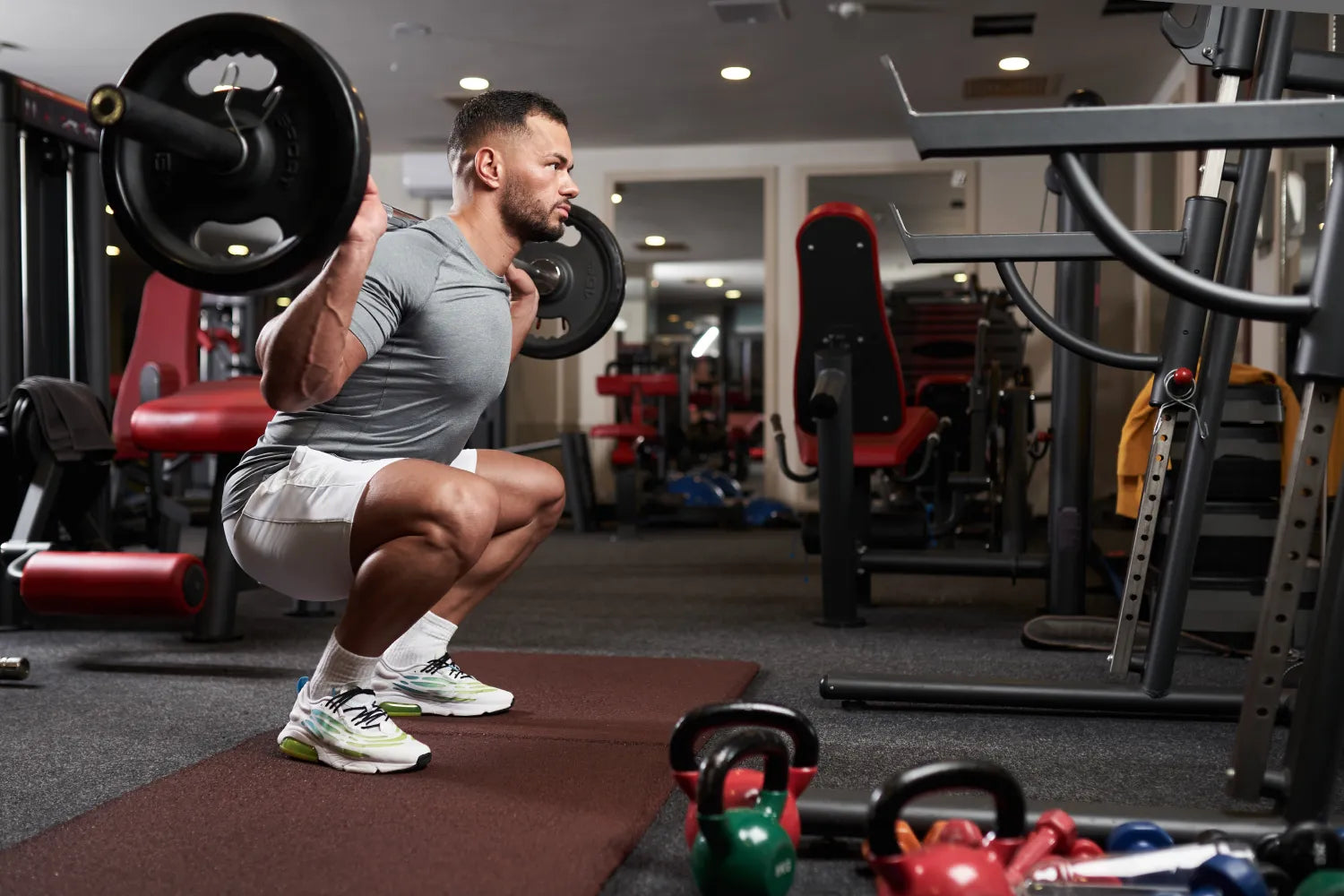
Key Takeaways
- Strength training helps runners improve endurance, reduce discomfort, and support joint health by targeting key muscle groups.
- A balanced plan includes smart programming, rest days, hydration, sleep, and the use of recovery tools like compression gear and hot/cold therapy.
- Runners who stay consistent with strength and recovery routines are more likely to stay active, feel better, and move stronger in the long term.
Running builds endurance, tests your limits, and offers a powerful way to stay active. But if you want to run your best, you can’t onlyrun.
Strength training plays a crucial role in helping runners move more efficiently, feel less tension, and support the body against the repetitive demands of the sport. Whether you're aiming to log more miles, beat a personal record, or just keep your knees and hips feeling good, adding strength work to your weekly routine is a game-changer.
Let’s break down what strength training actually does for runners, how to do it right, and what you can do to recover smarter and stay on track.
What Is Strength Training?
Strength training involves exercises that use resistance (like bodyweight, dumbbells, resistance bands, or weights) to challenge your muscles. The goal is to improve muscular strength, endurance, and stability by working against that resistance in a controlled way.
For runners, strength training is all about making muscles stronger and more capable of supporting the repetitive motion of running. A well-structured strength routine can support joint health, help reduce post-run discomfort, and boost performance over time.
It can include full-body movements, core work, and exercises that target the hips, legs, and stabilizing muscles that power every stride.
Why Does Strength Training Matter for Runners?
Running is a high-impact, repetitive activity. Over time, this can lead to muscular imbalances, fatigue, or feelings of joint and muscle discomfort, especially if the muscles that stabilize and support your stride aren’t strong enough to keep up.
Here’s what regular strength training can help support:
- Improved endurance: Stronger muscles work more efficiently, which can help reduce overall fatigue and support better pacing.
- Reduced risk of injury: When muscles, joints, and connective tissues are reinforced through strength training, they’re better equipped to handle the impact of running.
- Better posture and form: A strong core and glutes help keep your body aligned and stable, especially during long runs or hilly terrain.
- Balanced movement: Strength work helps correct imbalances between the front and back of the body, which are common in runners who rely too heavily on their quads.
Key Muscle Groups To Strengthen as a Runner
To build a strong foundation for running, focus on the muscles that directly influence your stride, shock absorption, and posture. These include:
- Glutes: These muscles drive hip extension and play a big role in propulsion and pelvic stability.
- Hamstrings and quads: Essential for leg movement and deceleration, they also help absorb impact forces.
- Calves: Important for push-off, ankle stability, and maintaining an efficient stride.
- Core: Includes not just the abs, but also the muscles that stabilize your spine and pelvis.
- Upper body: Strong arms and shoulders contribute to rhythm and balance, especially during longer runs.
Targeting these areas helps support the muscle control and joint stability needed to move well and recover faster.
Top Strength Exercises for Runners
You don’t need a fully stocked gym to get started. These exercises build functional strength using your bodyweight or simple weights like dumbbells or resistance bands.
The following exercises can help build strength in the lower body:
- Bodyweight squats/goblet squats: Build hip and quad strength
- Bulgarian split squats: Great for single-leg stability
- Romanian deadlifts: Focus on hamstrings and glute activation
- Reverse lunges: Promote balance and reduce knee stress
- Standing calf raises: Strengthen lower legs and ankles
And for core strength and upper body, consider adding these exercises to your routine:
- Planks (front and side): Strengthen deep stabilizing muscles
- Bird-dogs and dead bugs: Enhance spinal stability
- Push-ups and bent-over rows: Build upper body balance
Focus on quality form and controlled movement. Strength gains come from consistency, not from overloading too quickly.
How To Fit Strength Into Your Weekly Training Plan
If you're already running a few times a week, it’s important to slot your strength workouts strategically. We recommend scheduling two strength training days per week. Ideally, these are scheduled on days when you're not doing a long run or an intense speed workout.
It’s also a good idea to separate heavy lower-body strength days from your toughest running sessions to avoid fatigue-related soreness. Make sure you add mobility work or light core training to rest or recovery days to stay loose.
Your schedule might look something like this:
- Monday: Strength training
- Tuesday: Easy run
- Wednesday: Rest or mobility
- Thursday: Tempo run
- Friday: Strength training
- Saturday: Long run
- Sunday: Rest or walk
The key is to avoid overloading your system. Listen to your body, and give it the time and support it needs to adapt.
How Else Can You Elevate Your Performance?
Getting stronger and faster isn’t just about reps or mileage. It also depends on how you recover and refuel. Along with strength training, consider the following lifestyle shifts and tips to keep you running your best — and feeling your best as you go.
Hydration
Water is essential for circulation, joint function, and muscle recovery. Dehydration can increase the risk of cramps, soreness, and sluggish workouts.
Drink consistently throughout the day, and consider taking a water bottle or hydration belt with you on longer runs. It’s also important to stay aware of your electrolyte intake during high-intensity runs.
Nutrition
A balanced mix of carbohydrates, proteins, and healthy fats helps fuel training and rebuild muscle tissue. After strength sessions, aim to eat a protein-rich snack within 30-60 minutes to support muscle repair.
Sleep
Deep, restorative sleep is when your muscles recover and rebuild. Adults should aim for seven to nine hours of sleep each night. Even short-term sleep disruptions can lead to longer recovery times and lower performance.
Rest days
Your body builds strength during recovery, not during the workout itself. At least one full rest day each week (or two if needed) helps reduce tension, support joint health, and maintain training consistency over the long term.
Supporting Recovery With Smart Tools
It’s not just what you do during training but what you do between workouts that can make the biggest difference.
Here are a few recovery tools and strategies runners often rely on:
- Compression gear: Wearing compression sleeves or socks can help support circulation and ease feelings of tension or soreness after hard efforts.
- Hot and cold therapy: Cold is generally used for recently stressed or tense areas, while heat is helpful for older, lingering strains that need help relaxing.
- Foam rolling and massage: These tools help promote muscle relaxation and support mobility, especially in tight or overworked areas like the calves or quads.
- Dynamic stretching and mobility drills: Warming up and cooling down before and after each run, and maintaining a regular routine of dynamic stretching, especially focusing on the hip and ankle mobility, can support better stride efficiency and reduce post-run stiffness.
What Not To Do: Common Strength Training Mistakes
Knowing what to avoid is just as important as knowing what to do. Here are some common missteps:
- Skipping strength altogether: Many runners think endurance training is enough, but skipping strength work can lead to more discomfort, slower recovery, and imbalances over time.
- Overtraining: Too much volume without enough recovery time can set you back. More isn’t always better.
- Poor form: Rushing through exercises or lifting too heavy without proper control increases your risk of strain.
- No plan: Random workouts don’t support long-term performance. Strength training should be part of a structured plan that supports your running goals.
The Bottom Line
You don’t have to be a gym expert to benefit from strength training. The truth is, the strongest runners aren’t necessarily the fastest or the fittest. They’re the most consistent. And consistency comes from doing the little things right: training smart, prioritizing recovery, and supporting your body in the ways that matter most.
You deserve to feel strong and supported in every step. Whether you're training for your first race or working toward a new PR, strength work is a tool that keeps you going longer, stronger, and with more confidence.
You’ve got what it takes to stay in motion. And at Copper Fit, we’re here with compression gear and tips to help you move through soreness, keep discomfort in check, and keep going, because feeling your best shouldn’t be a finish line. It should be your everyday.
Sources:
Introduction to Strength Training | Penn State College of Medicine Research
Exercises to improve your core strength | Mayo Clinic
Sports and Hydration for Athletes: Q&A with a Dietitian | Johns Hopkins Medicine





